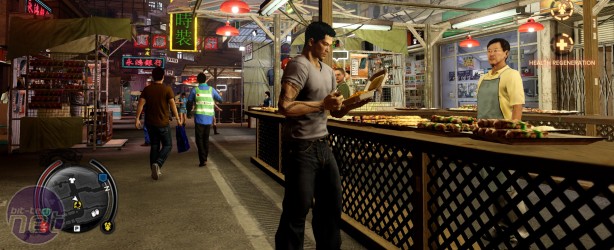
Sleeping Dogs Review
The formalisation of character progression into an RPG system is another area where Sleeping Dogs differs from GTA IV, especially since the upgrade tracks break down into a number of component scoring systems. The most important of these are Face, Cop and Triad, of which Face is basically your popularity and is used mainly as a means to gate certain content.The Cop and Triad meters, on the other hand, allow you to upgrade skills and abilities and are raised or lowered by activities relevant to those fields. Hacking CCTV cameras to complete a drug bust will boost your Cop score and allow you to get better with firearms, for example.
Consistently mow down innocents and plough through lamposts and you'll incur a Cop penalty for reckless driving, however.
Coupled with a wealth of side quests and collectibles, there's a dearth of content to pursue in Sleeping Dogs and enough city to explore that you'll be playing for weeks to come. Unfortunately though, in its rush to populate the game with so many different ideas and systems, developer United Front seems to have stumbled on some of the fundamentals.
Control in particular is a vital weakpoint, especially given the amped-up speed of most vehicles and the addition of a (very simple) free-running system. Hong Kong is a densely packed city, the bulk of which is made of twisty streets, uneven hills and narrow alleys - all of which are difficult to navigate at the speeds Wei jumps to.
The parkour system is especially flawed thanks to the way it jars with the environment. Wei's free-running looks amazing when it's in full-flow, but the sandbox environment means you're rarely dodging past cars and market stalls at the dead-on angles required to navigate them smoothly. The result is that you end up unable to clear things you should, or you leap wildly in the wrong direction.
The idea of parkour remains attractive enough and can be used brilliant with a few hours practice, but the fact that it doesn't mesh easily with the sandbox structure is a big problem. The fact is that no matter how much it's been re-styled to fit a new aesthetic, Sleeping Dogs still suffers from the same problems as every other similar shooter.
You know the ones. Missions are thinly veiled justifications, exploration is meaningless beyond the gathering of collectibles and while the game is supposed to be about player agency, the only things you can really do are drive and shoot.
Sleeping Dogs still manages to present an attractive alternative to the likes of GTA IV and has tried some interesting things to that end, but it ultimately lacks the polish to make those ideas as meaningful as they could be.
It's an alternative, rather than a superior - and none of the similarities or difference change that. The only real difference is that GTA IV came out years ago, while Sleeping Dogs has has the benefit of time. That means it's slightly disappointing that, while it's still fun enough, it fails to move beyond the shadows it's standing in.
-
Overall80 / 100


MSI MPG Velox 100R Chassis Review
October 14 2021 | 15:04











Want to comment? Please log in.